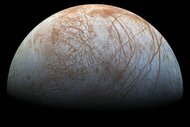Create a free profile to get unlimited access to exclusive videos, sweepstakes, and more!
Dwarf Galaxies Burned Off the Cosmic Fog to Shine the First Light on the Early Universe
It was like a trillion tiny candles in the dark.
Physically exploring the universe comes with some pretty serious limitations. Our most distant spacecraft is NASA’s Voyager 1. It launched on September 5, 1977, and nearly 50 years later it’s a little more than 15 billion miles from home. After a while, measuring distances in miles becomes prohibitive so we switch to measuring in AU (the average distance between the Earth and the Sun, roughly 93 million miles) or light-years (the distance light travels through space in a year, roughly 5.88 trillion miles).
Using those units, Voyager 1 is about 163 AU or 0.00257 light-years. If it keeps going at the same pace, it will have traveled 1% of a light-year about 150 years from now. By then, we might have more advanced spacecraft capable of traveling greater distances in shorter times. Maybe one day, some undreamt-of spacecraft will pass by Voyager on its way to the stars.
SYFY’s The Ark imagines one such spacecraft, an interstellar cargo ship ferrying humanity’s last hope to Proxima centauri, 4.2 light-years away. Even with a century of additional technology at their disposal, their journey to the star next door was years long, and it’s not over yet. Of course, those limitations only apply to physically sending things. Using telescopes and other astronomical instruments, astronomers are investigating the most distant locales in both space and time.
Recently, an international team of astronomers set their sights on the most distant stars possible to see. They went in search of the universe’s first light, and they found it in the faint glow of newborn dwarf galaxies which formed less than a billion years after the Big Bang. The discovery was published in the journal Nature.
For More on Stars:
What We Know about Mizar-Alcor, the Home of Resident Alien's Harry Vanderspeigle
Parasitic Black Holes Could Be Eating Some Stars (Including the Sun) from the Inside
MACHO Star System Has Supersonic Tidal Waves Taller Than the Sun
Searching for the First Starlight After the Universal Dark Ages
In popular consciousness, the Big Bang is often imagined as a brilliant explosion of light in the darkness, but that’s probably not what it looked like. In the beginning, as it were, the whole of existence was a thick soup of intermixed electrons, protons, and neutrons. There was nothing to shine a light with, and it couldn’t have gotten through the cosmic muck even if there were.
Roughly 380,000 years after the Big Bang, once the universe had expanded and cooled a bit, those particles began combining into light elements, mostly hydrogen and helium, during what’s known as the recombination period. The universe transformed from a murky soup of atomic ingredients to a transparent collection of atoms. The true first light comes from this event, the light created by the recombination of atoms created the microwave background radiation glow that still lingers over the whole of the cosmos.
What came next is known as the dark ages, so-called because there weren’t yet any stars and the universe was filled with a haze of neutral hydrogen. The first stars formed about 200 million years later, but their light couldn’t cut through the great cosmic fog of un-ionized hydrogen. We don’t know much about those earliest stars but we know they cleared the way, their radiation ionizing the gas around them and burning off the fog bit by bit. That transition is known as the reionization period, because radiation from the earliest stars knocked electrons around and reionized the universe’s hydrogen, jumpstarting the formation of future generations of stars and galaxies.
Taking advantage of all that relatively tightly packed matter, those earliest stars would have been huge, tens or hundreds of times the mass of the Sun. They would have burned hot and fast, gobbling up their fusible materials in just a few million years before exploding as supernovae to enrich the next generation of stars. Astronomers know it must have happened, but they weren’t sure precisely how reionization occurred, until now.
Dwarf Galaxies Cleared the Darkness from the Universe
Using the combined power of the James Webb Space Telescope’s advanced instruments and a gravitational lens assist (massive objects like black holes or galaxy clusters can bend space-time and magnify objects behind them) from the galaxy cluster Abell 2744, astronomers were able to study young, low-mass dwarf galaxies near the birth of the universe. There, they identified energetic stars capable of ionizing the surrounding gas and kicking off the reionization period.
“Something turned on that started pumping out very high energy photons into the intergalactic void. These sources worked like cosmic lighthouses that burned off the fog of neutral hydrogen. Whatever this was, it was so energetic and so persistent, that the entire universe became re-ionized,” study author Joel Leja said, in a statement. “If the other low-mass galaxies in the universe are as common and energetic as these, we think we finally understand the lighthouses that burned off the cosmic fog. They were incredibly energetic stars in many, many tiny little galaxies.”
Each individual galaxy may not have had much of an impact on the reionization effort of the overall universe, but there were a lot of them. According to the team’s models, the radiation from their combined light spread across the hazy cosmos, and was enough to clear the stage and turn up the house lights on existence.
“We found that small galaxies outnumbered massive galaxies by about a hundred to one during this epoch of reionization of the Universe. These novel observations also reveal that these small galaxies produced a considerable amount of ionizing photons, exceeding by four times the canonical values usually assumed for distant galaxies. This means that the total flux of ionizing photons emitted by these galaxies far exceeds the threshold required for reionization,” said the study’s first author, Hakim Atek, in a statement.
At present, the findings are based on a localized sample of early dwarf galaxies and the assumption that early dwarf galaxies in other parts of the universe behave the same way. Future studies will confirm that those galaxies are representative of the wider population across the early universe.
The Ark’s journey to Proxima centauri continues later this year, on SYFY.




































